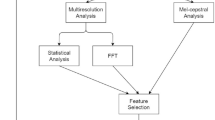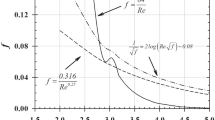Abstract
In this article a new acoustic parameter is introduced and it is shown that it may serve as an indicator of laryngeal function. It is termed the turbulent noise index (TNI) and is defined as 100(1−\(\bar R_{max} \)), where\(\bar R_{max} \) is the mean value of the maximum correlation coefficient between each pair of consecutive glottal cycles in the voiced signal. A method for its calculation is described. Experiments with synthetic and natural voice signals show that TNI is almost independent of frequency modulation noise and amplitude modulation noise. TNI is compared with HNR (harmonic-to-noise ratio) and NNE (normalised noise energy) which require high stationarity of the voice signal and are substantially affected by slow changes of frequency and amplitude. When the parameters HNR and NNE are used to discriminate between normal and pathological voices, the overlap area contains 21.5% and 23.5% of the total number of pathological voices, respectively. Using TNI, the voices, i.e. compared to the other noise parameters TNI has a significant advantage as a diagnostic parameter.
Similar content being viewed by others
References
Bielamowicz, S., Kreiman, J., Gerratt, B., Dauer, M., andBerke, G. (1996): ‘Comparison of voice analysis systems for perturbation measurement’,J. Speech Hear. Res.,39, pp. 126–134
Childers, D., andLee, C. (1991): ‘Vocal quality factors: Analysis, synthesis, and perception’,J. Acoust. Soc. Am.,90, pp. 2394–2410
Dejonckere, P. (1995): ‘Principal components in voice pathology’,J. Voice,4, pp. 96–105
De Krom, G. (1993): ‘A cepstrum-based technique for determining a harmonics-to-noise ratio in speech signals’,J. Speech Hear. Res.,36, pp. 224–266
Eskenazi, L., Childers, D., andHicks, D. (1990): ‘Acoustic correlates of vocal quality’,J. Speech Hear. Res.,33, pp. 298–306
Hillenbrand, J. (1988): ‘Perception of aperiodicities in synthetically generated voices’,J. Acoust. Soc. Am.,83, pp. 2361–2371
Hirano, M., Hibi, S., Yoshida, T., Hirade, Y., Kasuya, H., andKikuchi, Y. (1988): ‘Acoustic analysis of pathological voice’,Acta Oto-Laryngol.,105,pp. 432–438
Kasuya, H., Ogawa, S., Mashima, K., andEbihara, S. (1986): ‘Normalized noise energy as an acoustic measure to evaluate pathologic voice’,J. Acoust. Soc. Am.,80, pp. 1329–1334
Klingholz, F. (1987): ‘The measurement of the signal-to-noise ratio (SNR) in continuous speech’,J. Speech Commun.,6, pp. 15–26
Krieman, J., Gerratt, B., Kempster, G., Erman, A., andBerke, G. (1993): ‘Perceptual evaluation of voice quality: Review, tutorial, and a framework for future research’,J. Speech Hear. Res.,36, pp. 21–40
Michaelis, D., Gramss, T., andStrube, H. (1997): ‘Glottal to noise excitation ratio—A new measure for describing pathological voices’,Acust. Acta Acust.,83, pp. 700–706
Milenkovic, P. (1987): ‘Least mean square measures of voice perturbation’,J. Speech Hear. Res.,30, pp. 529–538
Mitev, P. (1999): ‘Method for measurement of the turbulent noise of acoustic voiced signals’,Proc. Technical University-Sofia,50, Book 2, pp. 121–128
Muta, H., Baer, T., Wagatsuma, K., Muraoka, T., andFukuda, H. (1988): ‘A pitch-synchronous analysis of hoarseness in running speech’,J. Acoust. Soc. Am.,84, pp. 1292–1301
Qi, Y., andHillman, R. (1997): ‘Temporal and spectral estimations of hamonics-to-noise ratio in human voice signals’,J. Acoust. Soc. Am.,102, pp. 537–543
Schoentgen, J., Bensaid, M., Bucella, F., andCiocea, S. (1998): ‘Issues in the acousttic evaluation of laryngeal disorders’. Proc. VOICEDATA 98, pp. 16–21
Yumoto, E., Gould, W., andBaer, T. (1982): ‘The harmonics-to-noise ratio as an index of the degree of hoarseness’,J. Acoust. Soc. Am.,71, pp. 1544–1550
Yumoto, E. (1983): ‘The quantitative evaluation of hoarseness. A new harmonics to noise ratio method’,Arch. Otolaryngology,109, pp. 48–52
Author information
Authors and Affiliations
Corresponding author
Rights and permissions
About this article
Cite this article
Mitev, P., Hadjitodorov, S. A method for turbulent noise estimation in voiced signals. Med. Biol. Eng. Comput. 38, 625–631 (2000). https://doi.org/10.1007/BF02344867
Received:
Accepted:
Issue Date:
DOI: https://doi.org/10.1007/BF02344867




